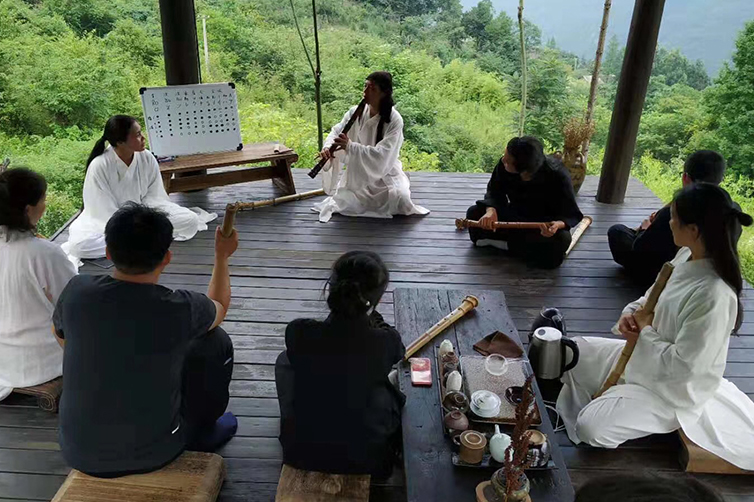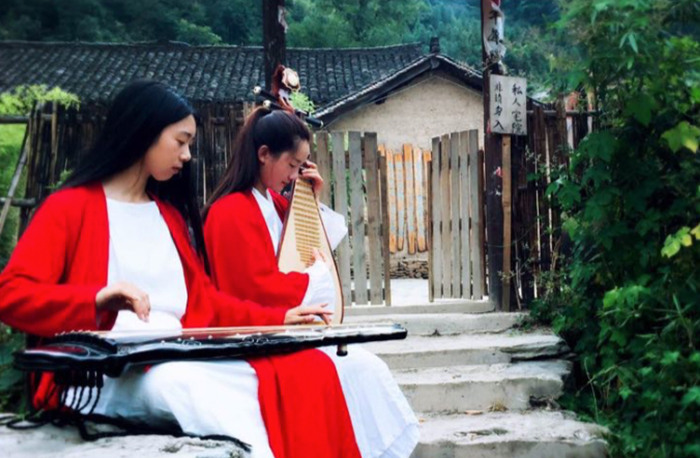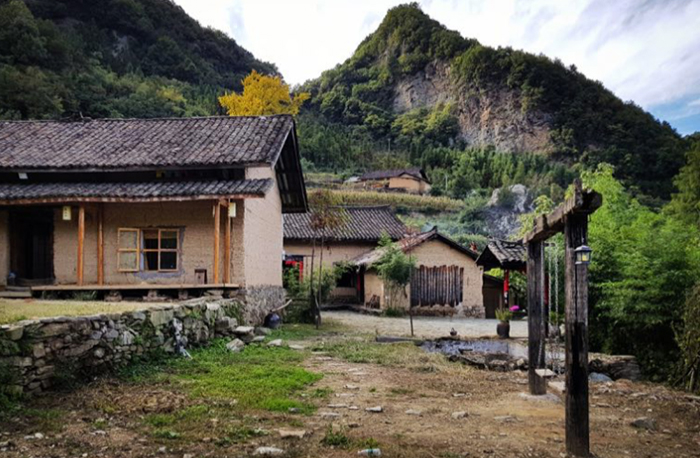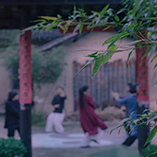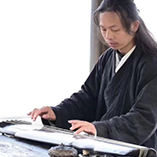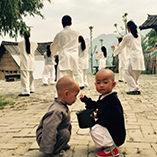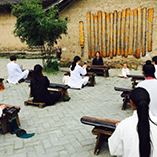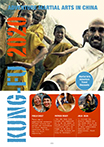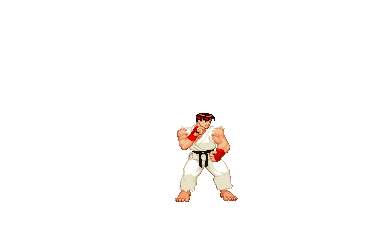Traditional Chinese Medicine, also known as TCM; includes a range of traditional medical practices from China. Often viewed as an alternative medical system in the west, it is considered part of mainstream medical care in east Asia. TCM practices include: herbal medicine, acupuncture, dietary therapy, both Tui na and Shiatsu massage, qigong and aspects of Chinese martial arts. TCM comes from a meticulous observation of nature, the cosmos, and the human body. Its major theories include those of Yin-yang, the Five Phases, the human body Channel system (Meridian theory) and Zang Fu organ theory.
TCM sees the human body as a small universe with a set of complete and sophisticated interconnected systems. Those systems usually work in balance to maintain the healthy function of the human body. The balance of yin and yang is considered with respect to qi ("breath", "life force", or "spiritual energy"), blood, jing ("kidney essence", including "semen"), other bodily fluids, the Wu Xing, emotions, and the soul or spirit (shen).
TCM has a unique model of the body, notably concerned with the meridian system. Unlike the Western anatomical model which divides the physical body into parts, the Chinese model is more concerned with function. Thus, the TCM spleen is not a specific piece of flesh, but an aspect of function related to transformation and transportation within the body, and of the mental functions of thinking and studying.
Traditional Chinese Medicines macro philosophy of disease means its diagnostics are based on an overall observation rather than "micro" level laboratory tests. For this eight guiding principles are employed to analyze and differentiate the energetic imbalances in the body or the nature of a patient’s condition using four diagnostic methods.
The four types of TCM diagnostic methods are: observe (wàng), hear and smell (wén), ask about background (wèn) and touching (qiè). The pulse-reading component of the touching examination is so important that Chinese patients may refer to going to the doctor as "Going to have my pulse felt." These methods are extremely important as considerable diagnostic skill is required to understand the full complexity of symptoms and dynamic balances.
The Eight Guiding Principles of TCM
TCM practitioners employ the Eight Guiding Principles to analyze and differentiate the energetic imbalances in the body, or the nature of a patient’s condition. The eight guiding principles actually consist of four polar opposites: yin/yang, cold/hot, deficiency (xu)/excess (shi), and interior/exterior.
Cold/Hot: This principle is used to determine the overall energy of the patient. A cold condition would be one marked by a slow metabolism, chills, pale skin, and a low-grade fever, while a hot condition would be characterized by a heightened metabolism, sensations of heat in the body, high fevers, and a flushed complexion.
Interior/Exterior: This principle describes symptoms in terms of the location of the patient’s problem. Exterior conditions are those caused by the invasion of the body by pathogens, and are usually acute and superficially located with a short duration. Exterior symptoms are those that affect the hair, skin, muscles, joints, peripheral nerves and blood vessels. Interior conditions result from pathogens that enter the interior of the body. Interior symptoms affect the organs, deep vessels and nerves, brain, spinal cord, and bones.
Deficiency/Excess: This principle describes the strength of an illness. In TCM, a deficient condition would be viewed as a lack of blood (such as in anemia), energy (Qi), heat, or fluids. Chronic illness would fall in this category. An excess condition, by contrast, means that the body has too much of something, such as qi or blood. In TCM, an acute condition would be seen as an excess condition.
Yin/Yang: These principles are the generalization of the above principles, and a condition can be categorized in terms of the relative dominance of either yin or yang. In Chinese medicine, all organisms have both yin and yang qualities and a balance of the two is necessary for good health. In general, yin energy is associated with cold, female energy, and represents the solid organs. Yang is associated with hot, male energy, and represents the hollow organs. Chronic illness is seen as yin, while acute illness is seen as yang.
According to TCM, the combination of these principles determines the nature or quality of the three constituents of the body, which are energy (qi), moisture, and blood. As described above, qi is vital life energy. Moisture is the liquid medium which protects, nurtures, and lubricates tissue, and blood is the material foundation out of which we create bones, nerves, skin, muscles, and organs.
TCM practitioners diagnose health problems using various combinations of the eight guiding principles. For example, a patient might be diagnosed as having an "internal cold" or "external heat" condition. Used in conjunction with the five element theory, the eight guiding principles give the TCM practitioner a more complete picture of a patient’s energy imbalances and determine the treatment to be pursued through acupuncture, herbs, diet, and exercise.
The Techniques for diagnosis are:
• Palpation of the patient's radial artery pulse (pulse diagnosis) in six positions.
• Observations of patient's tongue, voice, hair, face, posture, gait, eyes, ears and the vein on the index finger of small children.
• Palpation of the patient's body (especially the abdomen, chest, back, and lumbar areas) for tenderness or comparison of relative warmth or coolness of different parts of the body.
• Observation of the patient's various odors.
• Asking the patient about the effects of their problem.
• Anything else that can be observed without instruments and without harming the patient.
• Asking detailed questions about their family, living environment, personal habits, food diet, emotions, menstrual cycle for women, child bearing history, sleep, exercise, and anything that may give insight into the balance or imbalance of an individual.
Methods considered part of Traditional Chinese medicine: Acupuncture, Chinese herbal medicine, Cupping, Gua Sha, Moxibustion, Physical Qigong Exercises, Qigong, Tui na Massage, Die-da or Tieh Ta and Chinese food therapy.
Traditional Chinese medicine healing is a multidimensional process and understands that the body, mind, spirit and emotions must all be addressed in the healing journey. The mind and the emotions, which are the actions of the mind, play a powerful role in creating wellness or illness, and attracting disease.
All of these aspects and their relationships are mapped out in the theories that form the foundation of TCM: the theory of yin/yang, the theory of qi (or vital energy), meridian theory and the five-element theory. It is important to understand that these concepts and principles are not the product or result of scientific or rational thinking. They are based on a perception and deep understanding of natural law—how the universe really works at the level of energy.
One of the main goals of TCM is to identify and treat the root cause of conditions so that the healing is genuine and the condition does not reoccur. It's interesting to know that TCM doctors in ancient times were paid only if their patients remained well. The body has many ways of signaling imbalances; some can lead to more serious health problems if left untreated in a timely way. When these signs and signals are recognized and addressed early on in the healing process, you can achieve and maintain good health. In terms of treatment, TCM uses a variety of natural healing modalities to spark the individual's innate healing capacity. With health difficulties, this self-healing ability can become dormant, but it responds to natural forms of treatment and becomes active once again.
One very effective TCM specialty is prevention. As part of the healing process, each person should learn about lifestyle choices and their impact on wellness—how what he or she does, thinks and feels contributes to their state of wellness.
Chinese herbal medicine considered as the primary therapeutic modality of internal medicine. Of the approximately 500 Chinese herbs that are in use today, 250 or so are very commonly used. Rather than being prescribed individually, single herbs are combined into formulas that are designed to adapt to the specific needs of individual patients. A herbal formula can contain anywhere from 3 to 25 herbs.
As with diet therapy, each herb has one or more of the five flavors/functions and one of five "temperatures" ("Qi") (hot, warm, neutral, cool, cold). After the herbalist determines the energetic temperature and functional state of the patient's body, he or she prescribes a mixture of herbs tailored to balance disharmony. One classic example of Chinese herbal medicine is the use of various mushrooms, like reishi and shiitake, which are currently under intense study by ethno botanists and medical researchers for immune system enhancement.
Taoist Yoga comes from the tradition of Tao Yin (Dao Yin), of Han Dynasty China, whose earliest transcripts date back to about 180 BC. The Tao or way, as it is often translated, is the underlying component of reality. It is the infinite rhythm of our cosmos that every aspect of our life adheres to. It is the vibration of the electrons in atoms, the rotation of the earth and its revolution around the sun, the changing of the seasons and the rhythmic breath and heartbeat that keeps us alive and animated. The Tao comprises two opposite but interdependent aspects called Yin and yang. Yang is the sun, the fervent, aggressive, powerful aspect of the universe. Yin is the shade, the nurturing, maternal and gentle aspect of the universe. The underlying governing agent of Tao is Qi or the Underlying Vital Energy of all Life and the Universe.
The idea of Qi, which is inherently Chinese, is similar to the Yogic term Prana which is from India. It is nice to see how two very different cultures can share an idea that is so pivotal to each of their traditional spiritual practices and ways of understanding reality. Tao Yin is the cultivation and understanding of Tao through soft, gentle, healing and nourishing exercises. The early Taoists developed many practices geared toward keeping themselves healthy and prolonging their life so they could spend more time practicing, studying and meditating to understand the deepest aspects of Tao. The postures and exercises of Taoist Yoga are unique and generally have no relation to Hatha Yoga. In regards to the similarity of Hatha Yoga and Taoist Yoga we may look to the fundamental teaching of the 'Three Regulations' in traditional Taoist Yoga Doctrine. These are the 'Regulation of Posture', 'Regulation of Breath', and 'Regulation of Heart/Mind'.
It can be viewed that Hatha Yoga also shares the practice of these Three Regulations, and herein lie their similarity. Taoist Yoga has at its core a unique and special process of Breath Training:
The Taoist Yoga Breath Training will generally go through Three Stages of Development that are termed:
1. Natural Breathing - After Heaven Quality -
2. Reversed Breathing - Before Heaven Quality -
3. Fetal Breathing - Before, Before Heaven Quality -
Each Taoist Yoga stage of breathing can have generally 9 methods that are put into application and training such as: inhale from nose/exhale from nose, inhale from nose, exhale from mouth, inhale from mouth/exhale from mouth, breathing through energetic points, breathing through energetic channels, subtle refined breathing, and so on...
Both Hatha Yoga and Taoist Yoga have different exercises, philosophies and breathing techniques, but the underlying foundation practice is very similar in regards to the shared practice of 'The Three Regulations. One unique quality of Taoist Yoga is the stress we find on developing and nurturing the Vital Energy. The benefit of this training and nurturing of the Vital Energy results in a long history of practitioners gaining amazing self healing, self rejuvenation of the body, and longevity. The way for a person to realize his or her own personal truth must be taught in an individual way.
Focus must be placed on teaching how a person can come to understand truth and beauty through pure and simple means. There is no harm in leading all people to the secrets that have been unfairly protected through dogma over the past centuries. The nature of the Tao is to change, move and be spontaneous. Therefore no one teaching can hold the secrets to the Tao. It will be different for each person at different times in his or her life
